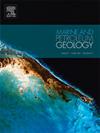Milankovitch-driven terrigenous deposit influx in Middle Ordovician marine successions of Western Australia: Insights for paleoclimate and geochronology
IF 3.7
2区 地球科学
Q1 GEOSCIENCES, MULTIDISCIPLINARY
引用次数: 0
Abstract
This study investigates the terrigenous sediment influx in the Canning Basin, Western Australia, during the Darriwilian Stage of the Middle Ordovician, specifically correlating it with Milankovitch obliquity cycles. The basic stratigraphic data came from the Goldwyer Formation within Theia 1 well which was dated using the U-Pb zircon geochronology. Four ash beds, located in the lower part of the formation, yielded distinct radiometric ages at depths of 1550.81 m (466.07 ± 0.12 Ma), 1559.81 m (466.31 ± 0.11 Ma), 1572.55 m (466.84 ± 0.11 Ma), and 1587.10 m (467.12 ± 0.14 Ma) which following the age of conodont biostratigraphy. Based on the astrochronological analysis, duration of the Darriwilian in the Canning Basin is estimated at 9.03 ± 0.3 Myr, providing a precise chronological framework for the studied sedimentary successions. Core sample examinations indicated notable lithological discrepancies with a pronounced increase in terrigenous sedimentation recorded during intervals of elevated obliquity. Quantitative analysis revealed that sedimentation rates reached their zenith in correlation with ∼1.2 Myr obliquity cycles, resulting in substantial accumulations of fine-grained sediments, notably shale and mudstone. Petrographic examination identified a predominance of silt and clay-sized particles during these high influx periods, confirming a direct relationship between obliquity and sediment composition and led to enhanced fossil preservation. ICP-MS analysis of 39 samples indicated variations in elemental abundance that corresponded with the identified obliquity cycles, further supporting the correlation between climate changes and sediment influx. Scatter diagrams illustrated the relationships between various geochemical proxies, revealing trends that align with the sedimentary data. The findings confirm that the Canning Basin experienced significant shifts in sedimentation patterns driven by obliquity-induced climate changes during the Middle Ordovician. This research demonstrates how obliquity affects sedimentation rates and fossil preservation in the Canning Basin, enhancing our understanding of its geological history.

求助全文
约1分钟内获得全文
求助全文
来源期刊

Marine and Petroleum Geology
地学-地球科学综合
CiteScore
8.80
自引率
14.30%
发文量
475
审稿时长
63 days
期刊介绍:
Marine and Petroleum Geology is the pre-eminent international forum for the exchange of multidisciplinary concepts, interpretations and techniques for all concerned with marine and petroleum geology in industry, government and academia. Rapid bimonthly publication allows early communications of papers or short communications to the geoscience community.
Marine and Petroleum Geology is essential reading for geologists, geophysicists and explorationists in industry, government and academia working in the following areas: marine geology; basin analysis and evaluation; organic geochemistry; reserve/resource estimation; seismic stratigraphy; thermal models of basic evolution; sedimentary geology; continental margins; geophysical interpretation; structural geology/tectonics; formation evaluation techniques; well logging.
 求助内容:
求助内容: 应助结果提醒方式:
应助结果提醒方式:


